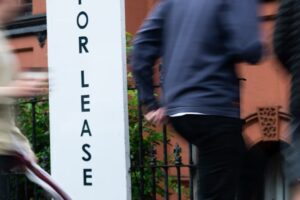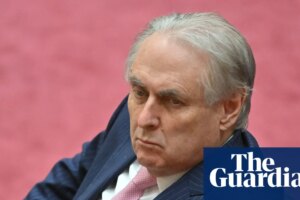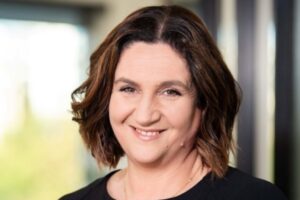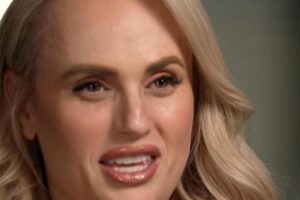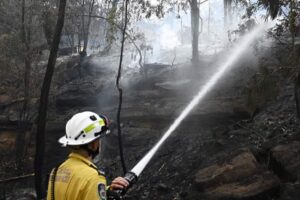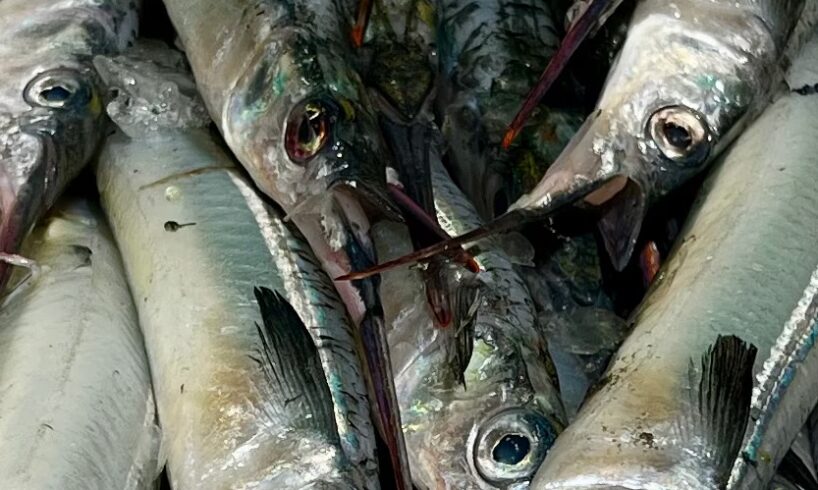
The South Australian government is placing temporary restrictions on commercial fishing in the Gulf St Vincent/Kangaroo Island fishing zone.
The government said stock assessments in the waters of Gulf St Vincent, Kangaroo Island and Spencer Gulf have revealed declines in species including blue swimmer crab, whiting, calamari, and garfish — particularly in the Gulf St Vincent.
Premier Peter Malinauskas said, as a result, all commercial fishing will be temporarily banned in the Gulf St Vincent/Kangaroo Island fishing zone, while recreational fishing limits for all species in that zone would be halved from November 1.
Garfish are among the species subject to the temporary fishing restrictions in an attempt to help numbers increase back to normal levels. (ABC News: Caroline Horn)
He said that more people were opting to fish at the Spencer Gulf, and therefore, restrictions on recreational fishing for calamari, garfish, blue crab and King George whiting were also necessary in that fishing zone.
“We don’t want a set of circumstances where Spencer Gulf ends up getting over-fished because the effort is simply moving from the Gulf St Vincent to Spencer Gulf,” he said.
“As a result of that, the government has received advice that we should curtail or reduce bag limits and boat limits for the fishing sector and the charter sector in Spencer Gulf as well, which we are doing for those key species.”
The restrictions will remain in place until June 30, 2026, subject to regular scientific review in an effort to help enable fish stocks to replenish.
Thousands of dead marine creatures have washed up along South Australian beaches since the algal bloom was first detected in early 2025. (ABC South East SA: Caroline Horn)
“However, for the southern area and the west coast, it’s unaffected and people can continue to fish at their leisure,” Mr Malinauskas said.
“In SA, we have one of the best regulated fisheries anywhere in the world; there are catch limits, there are bag and boat limits, there are quotas in place, all of which are informed by research and science to make sure that we honour what is our fundamental duty, and that is to ensure that we have a sustainable fishery, not just for now, but for future generations.”
Mr Malinauskas said the latest algal bloom data, however, gave “reason for some optimism”, while adding that he wanted to be “exceptionally cautious” given the ever-changing conditions.
Mike Steer says the algal bloom is trending in the “right direction”. (ABC News: Lincoln Rothall)
Mike Steer, the executive director of the SA Research and Development Institute, said water testing and satellite imagery indicate the algal bloom is trending in the “right direction”.
He said the data show increased algal concentrations at 15 sites, mostly in Adelaide metropolitan areas.
“This is the area that we’re most concerned about because it’s where the bloom is at the minute, we are seeing the foaming events occurring when we’ve got strong westerly winds and choppy conditions, and we’re likely to see that a lot more as we go into the November weather system,” Professor Steer said.
He added there had been decreases across nine sites, while 73 sites around the state have remained steady.
Professor Steer said the algal bloom taskforce was monitoring conditions in the Adelaide metropolitan area closely amid changing weather conditions.
The latest water testing and satellite imagery shows 15 sites have increased algal concentrations, nine sites have seen a decrease, and 73 sites have remained steady. (ABC News: Lincoln Rothall)
The government announced it would support fishers by making it free to launch their boats from the state’s ramps and remove vehicle access fees for coastal national parks amid the changes to catch limits.
“On top of that, I can announce today that starting on the 1st of December this year for 12 months, we will halve the cost of boat registration for trailer boats for both the boat and the trailer,” Mr Malinauskas added.
“We have also made the decision today to expand again right up to the 30th of June, the commercial fishing fee relief and also the commercial support to our commercial fishing sector.”
Mr Malinauskas said the government would invest $3 million in a threatened and vulnerable marine species program, and an additional $4 million for the state’s saltwater fish restocking program.
“While there is good news that the algal bloom is heading in the right direction, there is a lot of damage that has been done,” he said.
“We’ve now got science that tells us more about what’s happened to fish stocks, and we’ve got an obligation to act to accelerate the recovery.”
Kyri Toumazos is the Seafood Industry SA’s chief executive. (ABC News: Lincoln Rothall)
Industry stakeholders welcomed the announcements.
“The decision to look after fish stocks in a trajectory of rebuilding over the next period is the right decision, which we fully support,” Seafood Industry SA executive officer Kyri Toumazos said.
“Seafood Industry SA is facing probably the hardest decision and the hardest journey that we’ve had in the history of commercial fishing in South Australia.”
Australian Fishing Trade Association chair Bob Baldwin said the changes would ensure fishing and associated industries would remain viable in the region.
“Whilst it’s a tough decision when you’re getting some cutbacks, when you understand what you’ve got to do to build a pathway to sustainability, you can work with it,” he said.
“The premier is investing in keeping our retailers alive.
“The billion-dollar industry here isn’t just tackle shops — it’s all the caravan parks, it’s the hotels, it’s the restaurants, it’s the broader suppliers. We are part of the tourism economy, and we want to make sure that we stay part of that, and the longevity is by making proactive and sensible, and sustainable decisions.”
